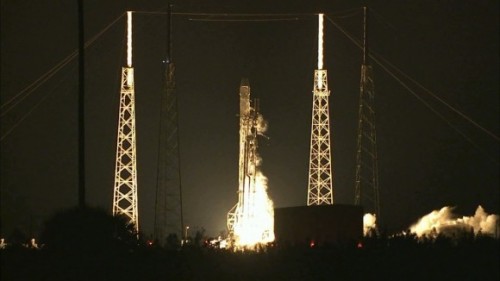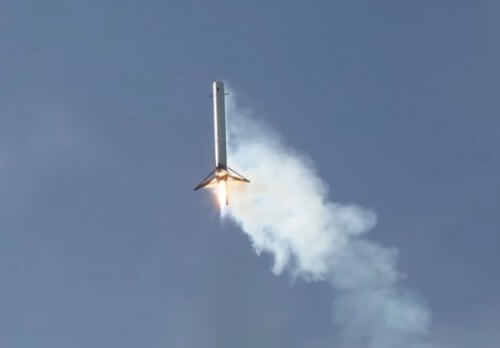It was the first attempt by SpaceX to land the first stage of a rocket outside of the ocean itself, so that in the future this type of launchers can be reused to lower the costs of launching into space

SpaceX today (Saturday) successfully launched a Falcon 9 rocket carrying a Dragon cargo spacecraft to the space station. However, the second half of the mission - landing the first stage of the missile on an unmanned rig in the heart of the Atlantic Ocean resulted in a hard landing - in the right place, but at too high a speed. Despite this, the company says that this is the first step on the way to the company's ambitious goal of landing and in the future even reusing the launch missiles.
The spacecraft was launched at 04:47 EST (11:47 Israel time) and the company defines it as a part. The nine Marlin 1D rocket engines created a thrust of about 500 tons. The Dragon spacecraft will arrive at the International Space Station on Monday. It is loaded with supplies weighing over 2 tons and supplies for the six crew members staying at the station.

A secondary goal that SpaceX set for itself in this mission was to carry out the historic attempt to land the first stage of the Falcon rocket, which is as tall as a 14-story building on a platform in the middle of the sea, which it called - an autonomous space port in the middle of the sea.
SpaceX CEO Elon Musk tweeted that progress has been made but there is still a lot of work ahead. "It was an experiment that involved re-igniting the engines of the first chip three times against the direction of the spacecraft's movement to slow it down and try to land on the rig.
Indeed, the missile managed to land on the rig but it was a hard landing. "The ship itself is in good condition, but some of the support equipment on board will need to be replaced." Musk wrote.
The autonomous rig was waiting for the rocket about 350 km from the launch site in the rocket's flight path over the Atlantic Ocean following the northeast coast of the USA to match the trajectory of the Dragon spacecraft to that of the International Space Station.
As mentioned, the dimensions of the rig are 300 x 100 feet (approximately 91 x 30.5 meters) and the diameter of the missile standing on its legs is 170 feet (approximately 52 meters). This is a tiny bone compared to the Atlantic Ocean. Therefore, the flight controllers of the SpaceX company were helped to use thrust engines to control the falling speed of the rocket and directed it to an exact point in the middle of the ocean, even if not as slowly as they thought.
They are now planning the next landing attempt.
Landing attempt of a Falcon 9 missile thrown from a plane.

17 תגובות
Hot news (if I'm not mistaken).
The last attempt to land a Falcon missile failed. On YouTube you can see that the missile landed vertically, but rather tilted very much on its side.
A possible explanation on behalf of the company Spaceyx:
About a minute (?) before landing, the hydraulic fluid ran out in some system in the missile (without it there is no mechanical control in the aforementioned system). If I understood correctly, you are the narrator - in the next attempts, the amount of hydraulic fluid will be increased.
Pierre Tullery.
The Falcon is probably the best thing out there (not many practical suggestions). The Falcon was designed from the beginning as a reusable launch vehicle, if my memory serves me correctly, its design was from 7 years ago or more, from the very beginning they thought about landing using burners, because the alternatives were not good.
The down method is the method of the ferries and it turned out that this method does not work. The method does not work because it is very difficult to place a tool without the placed tool having "independent" movement. In other words, the landing craft must maneuver the landing while landing. A glider without independent maneuverability.
It is possible that there are other stages for the launch rocket, smaller than the first stage (the one discussed in the experiment), in which they will also want to use multiple use. If there are more stages of the launch rocket (for multiple use) - they may be landed in a different way that is more suitable than the way of landing the first stage. Each rocket stage is a separate story.
The owner of the project, Elon Musk as I imagine, has a lot of money. Also, it is more efficient in utilizing the money than a state, this is an example where privatization is worthwhile.
Yehuda, welcome, and thanks for the correction, I got into trouble with all the conversions from American sizes to normal sizes 🙂
Indeed, this is an important project that should be followed.
Please accept a correction. Falcon 9's first stage engines produce a thrust of half a million kg (500 tons) and not half a million tons. Editorial note: This is not only the first attempt to land a rocket on a rig, but (mainly) the first attempt in the jubilee years of using rockets for space exploration that try to use the first stage of a rocket powered by liquid fuel (as opposed to the boosters of the late Shuttle), which usually Crashing into the sea. No government space agency, not NASA, not the European agency, not the Russians, has even claimed to be successful in such an operation. Remember, this is a body whose main part is a huge fuel tank (the size of a passenger plane) made of a thin shell (you can make a hole in it with a pointed pencil) which should land vertically on 3 thin feet after a free fall from a height of about 40 kilometers! Whoever thinks it's easy, should first try to drop a bottle from a height of one meter without breaking it.
Maybe the missile is not suitable, something like a glider, or similar to an airplane? Virgin Galactic dropped out of the chapter, but there was a kind of prototype there. If a serious country would have backed it, something would have come out of it.
So I checked and it turns out I was wrong, surveyors' GPS equipment reaches an accuracy of 2 millimeters.
The accuracy of the GPS is about 30 centimeters with accepted correction techniques (these devices are more sophisticated than the GPS in the smartphone). It is also possible to reach an accuracy of 3 cm, but only with stationary devices that are used for measuring. For very fast movement or in the case of heavy cloud cover that interferes with the reception of the signals from the satellites, transmitters can be added - electronic or optical, but they cannot be on the barge (perhaps one is) but a few kilometers away from the barge, in order to obtain a high accuracy of position in space. A transmitter on the barge will only give the distance of the first stage from the barge, not directions.
One can think of a system similar to the one used to land commercial traffic. For example - 4 transmitters in the corners of the landing surface that transmit upwards and outwards, creating an inverted pyramid out of nowhere. The missile receives signals from the 4 transmitters and ensures that the strength is the same on each channel.
Herzl, yes, I heard about GPS but I remembered that its level of accuracy is around 10 meters which is not accurate enough for this landing.
Skeptic, you're right, I thought about something like that too.
Herzl
Why does he need satellite GPS? It is possible to place signal transmitters similar to those of the GPS on the barge, except that their signals will be more accurate. Other methods are also possible, for tuning.
To everyone: Have you heard of GPS???
And for the translator: the length of the missile is 52 meters and not its diameter.
And regarding the hard landing - I wonder what the reason is, an error in the calculations (newton/pound added) or a malfunction in the engine. I guess we'll hear soon. I wish them success!
Danny, regarding the cows it sounds reasonable, regarding the breeder I'm not sure, you should check.
In the first stage he communicates with the cows on the ground-
You can see them when it reaches the ground.
When he's taller and it's hard for him to communicate with the cows-
He makes contact with the tower to the left of the landing site and likely has suitable equipment on it
which helps him find his position in space.
To my father
The video under it reads: "An attempted landing of a Falcon 9 missile that was thrown from a plane."
Describes an attempted landing of a missile that took off from the ground.
The spacecraft fires laser beams at the rig
There are receptors on the rig
The rig returns to the spacecraft's computer the coordinates where the rays hit.
I'm not a physicist so I have no idea about the penetration of the rays but just a thought
How does he manage to be so precise in landing when such a big cloud of smoke and dust rises up that hides everything from his point of view?
What method does he use to direct himself to the X that is marked on the ground? (and the dust/smoke does not allow you to see it at all)